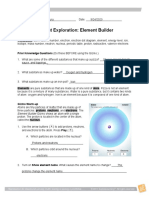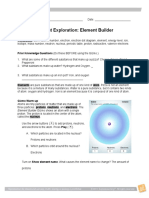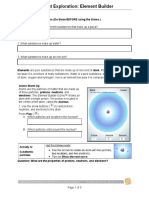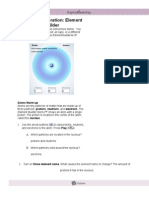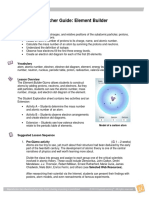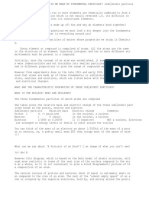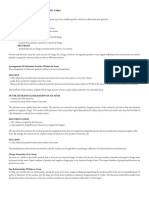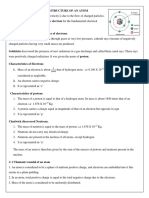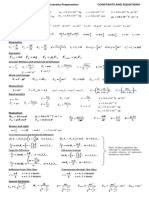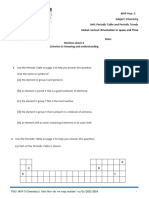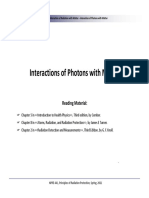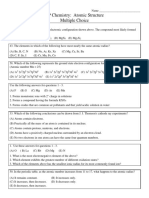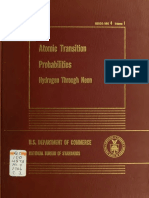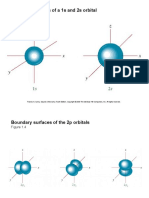Name: ______________________________________ Date: ________________________
Student Exploration: Element Builder
Vocabulary: atom, atomic number, electron, electron dot diagram, element, energy level, ion,
isotope, mass number, neutron, nucleus, periodic table, proton, radioactive, valence electrons
Prior Knowledge Questions (Do these BEFORE using the Gizmo.)
1. What are some of the different substances that make up a pizza? _______sauce cheese
dough and pepperoni______________
_________________________________________________________________________
2. What substances make up water? _two_hydrogen_atoms and one oxygen
atom__________________________________________
3. What substances make up an iron pot?
_iron________________________________________
Elements are pure substances that are made up of one kind of atom. Pizza is not an element
because it is a mixture of many substances. Water is a pure substance, but it contains two kinds
of atom: oxygen and hydrogen. Iron is an element because it is composed of one kind of atom.
Gizmo Warm-up
Atoms are tiny particles of matter that are made up of
three particles: protons, neutrons, and electrons. The
Element Builder Gizmo shows an atom with a single
proton. The proton is located in the center of the atom,
called the nucleus.
1. Use the arrow buttons ( ) to add protons, neutrons,
and electrons to the atom. Press Play ( ).
A. Which particles are located in the nucleus?
_neutrons and
protons______________________________
__
B. Which particles orbit around the nucleus?
___electrons__________________________
_____
2019
�2. Turn on Show element name. What causes the element name to change? The mass
number and atomic number_____________
_________________________________________________________________________
2019
� Get the Gizmo ready:
Activity A:
Use the arrows to create an atom with two protons,
Subatomic
two neutrons, and two electrons.
particles
Turn on Show element name.
Question: What are the properties of protons, neutrons, and electrons?
1. Observe: Turn on Show element symbol and Element
notation. Three numbers surround the element symbol: the
mass number (A), electrical charge (no number is displayed if
the atom is neutral), and the atomic number (Z).
2. Investigate: Watch how the numbers change as you add or
remove particles.
A. Which number is equal to the number of protons in the atom?
_neutrons_________________
B. How can you calculate the number of neutrons (N) in an atom? subtract
the
number of protons, or atomic number, from the mass
number. _________________
___________________________________________________________________
C. Which particle (proton, neutron, or electron) has a positive charge?
_proton_____________
Negative charge? ___electron___________ No charge at all?
__neutron____________
3. Analyze: An isotope is an alternative form of an element. Each isotope of an element has
the same number of protons, but a different number of neutrons. The isotope is represented
by the atomic symbol and mass number, such as He-4. Some isotopes are stable, while
others are radioactive, which means the atoms decay over time and emit radiation.
A. What are the stable isotopes of carbon? ___C12 and
C13________________________________
B. What are the stable isotopes of nitrogen? __nitrogen-14 and nitrogen-
15________________________________
C. List two radioactive isotopes of oxygen: ____oxygen-13 and oxygen-
14_______________________________
2019
�4. Practice: Use the Gizmo to answer the following questions.
A. How many electrons are in a neutral atom of lithium? _three_____
B. How many neutrons are in an atom of Mg-25? ___13___
C. What is the mass number of an atom with 5 protons and 7 neutrons? ___12___
D. When an atom is charged, it is called an ion. How many electrons are in O2-? ___2
and 6___
E. How many electrons are in Mg2+? ___10___
2019
� Activity B: Get the Gizmo ready:
Electron Create a neutral hydrogen atom (1 proton, 0
arrangements neutrons, 1 electron).
Question: How are electrons arranged around the nucleus of an atom?
1. Observe: Add electrons to the atom until you have used all the available electrons. How are
the electrons arranged? By
group______________________________________________________
_________________________________________________________________________
2. Analyze: Electrons are arranged in orbits called energy levels. The Gizmo shows all of the
first two energy levels but only part of the third energy level.
A. How many electrons can fit in the first energy level? ____6_______
B. How many electrons can fit in the second energy level? _______6____
C. How many electrons fit in the part of the third energy level shown? _6__________
3. Observe: Click Reset ( ). The electrons in the outermost orbit, called valence electrons,
help to create chemical bonds. Create a lithium atom (3 protons, 4 neutrons, 3 electrons).
How many valence electrons are in a neutral lithium atom? ___one________
4. Diagram: Turn on Show electron dot diagram. The valence electrons of an atom are
shown in an electron dot diagram. Each dot represents a valence electron.
Draw the electron dot diagram for neutral lithium: __Li._________
5. Practice: Turn off Show electron dot diagram. Use the Gizmo to create a neutral atom of
each of the following elements. Draw an electron dot diagram for each. When you are
finished, turn on Show electron dot diagram and check your answers.
H He Li Be B C N
O F Ne Na Mg Al Si
6. Extend your thinking: Many chemical properties are determined by the number of valence
electrons. Elements with the same number of valence electrons will have similar properties.
2019
�Which element has similar properties to lithium? _________ Beryllium? _________
Explain: __________________________________________________________________
2019








